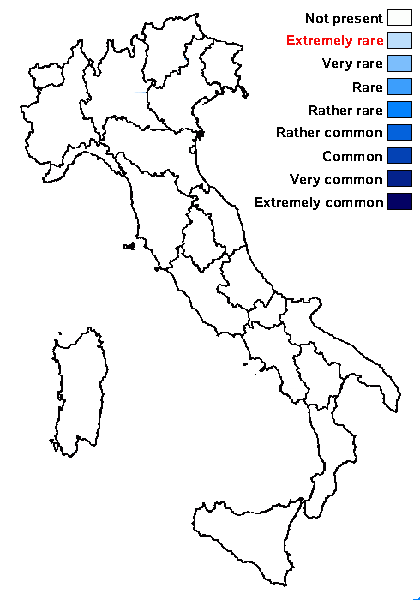Tephromela pertusarioides (Degel.) Hafellner & Cl. Roux
Bull. Soc. bot. Centre-Ouest, N. sér., n. spec., 7: 829, 1985.. Basionym: Lecanora pertusarioides Degel. - Uppsala Univ. Årsskr.: 157, 1939.
Synonyms: Lecanora massalongiana Gyeln. non Zahlbr.
Distribution:
Description: Thallus crustose, episubstratic, pale grey to whitish grey, irregularly cracked to verrucose-areolate, up to 1.5 mm thick, sorediate, sometimes delimited by a dark prothallus. Soredia whitish to grey-white, 80-200 µm thick, arranged in initially well-delimited, orbicular, 0.4-2 mm wide, scattered, hemispherical soralia. Cortex unpigmented, 15-30 µm thick, overlain with an epinecral layer; medulla white, thin, without crystals of calcium oxalates, I-. Apothecia very rare, lecanorine, usually constricted at base, round or irregular, with a black disc and a thick, white thalline margin. Proper exciple thin, mostly colourless; epithecium dark violet-red, N+ red; hymenium violet-red, I+ blue, N+ red; paraphyses strongly coherent,simple or sparingly branched, the apical cells not markedly swollen, but with a pigmented cap; hypothecium brown. Asci 8-spored, clavate to cylindrical-clavate, the apical dome K/I+ dark blue with a pale, conical-pointed apical cushion (axial mass), the wall I-, but the thin outer gel I+ blue, Bacidia-type. Ascospores 1-celled, hyaline, ellipsoid, 10-15 x 6-8 µm. Photobiont chlorococcoid. Spot tests: cortex: K+ yellow, C-, KC- or KC+ weakly yellow, P-; medulla K-, C-, KC+ violet-red, P-, UV+ white. Chemistry: cortex with atranorin, medulla with ±α-collatolic and alectoronic acids (major or minor). Note: on siliceous rocks e.g. on cliffs in rather open forests; widespread in Europe but apparently rare; from the Alps there are only a few scattered records outside the Italian territory, where the species should be looked for; the species may be a sorediate form of T. atra.
Growth form: Crustose
Substrata: rocks
Photobiont: green algae other than Trentepohlia
Reproductive strategy: mainly asexual, by soredia, or soredia-like structures (e.g. blastidia)

Predictive model
Herbarium samples
Growth form: Crustose
Substrata: rocks
Photobiont: green algae other than Trentepohlia
Reproductive strategy: mainly asexual, by soredia, or soredia-like structures (e.g. blastidia)

Predictive model
| Herbarium samples |
 INDEX FUNGORUM
INDEX FUNGORUM
 GBIF
GBIF
 DOLICHENS
DOLICHENS

